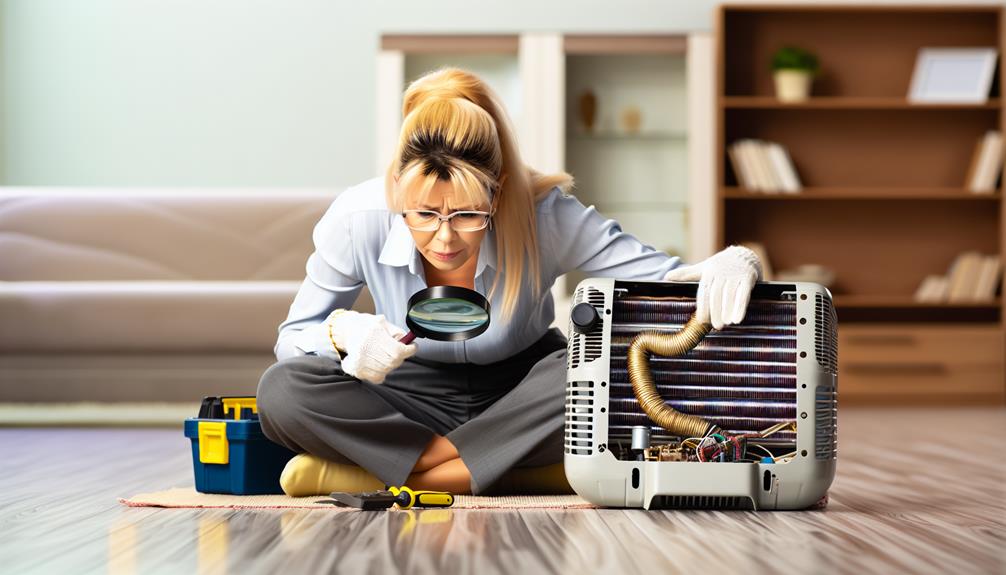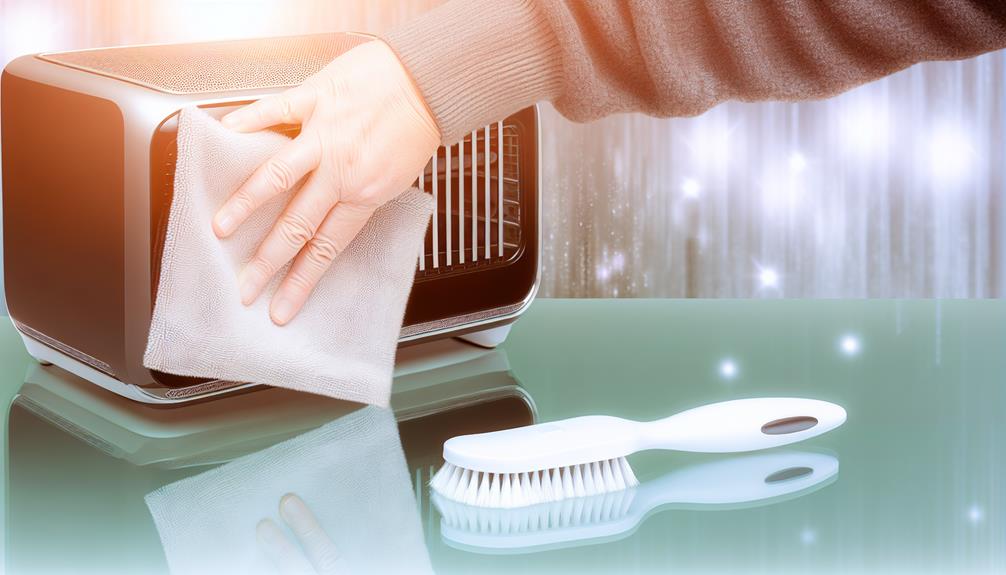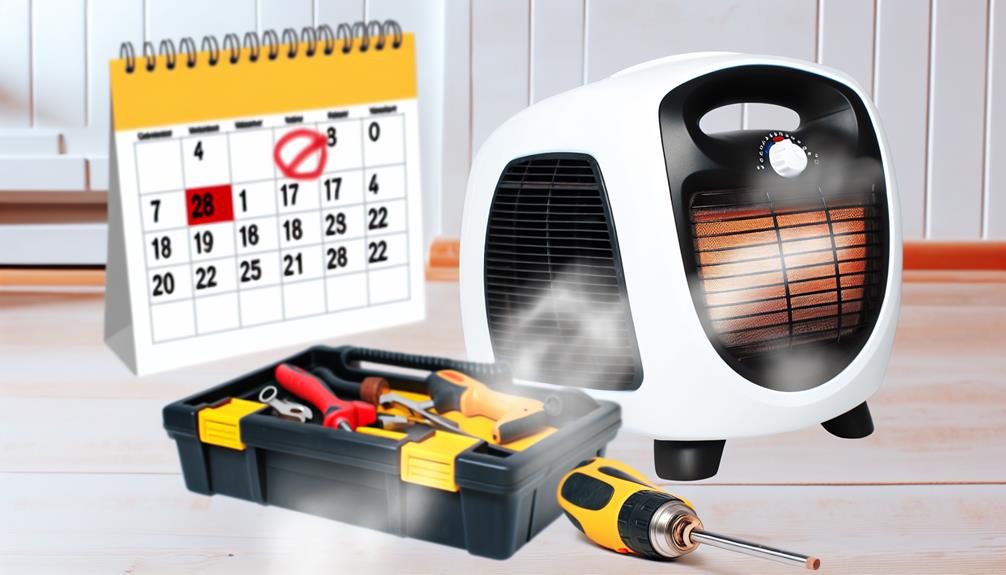Just as Achilles' heel was his singular point of vulnerability, your portable heater too has its Achilles' heel in the form of neglect. It's essential to understand that your comfort during chilly days hinges on the well-being of this humble appliance. You've likely invested in a portable heater for its convenience and ability to warm your personal space efficiently. However, without proper care, its performance can dwindle, costs can soar, and it may even become a safety hazard. To ensure that your investment continues to pay off, you'll need to heed some key maintenance advice. You're standing at a crossroads – one path leads to sustained warmth and reliability, while the other could lead to the untimely demise of your trusted heat source. So, what are the secrets to preserving the quality and longevity of your portable heater? Stick around to uncover the pivotal steps that stand between you and the unwelcome cold.
Key Takeaways
- Regular inspections and cleanings are essential for removing dust and debris buildup and ensuring the safety and efficiency of your portable heater.
- Selecting appropriate locations and ideal heater placement, such as keeping it on a stable, nonflammable surface and away from anything that can burn, is crucial for safe operation.
- Avoiding obstruction areas and keeping the heater at least three feet away from combustible materials, as well as avoiding using it in workshops or garages with flammable substances, helps prevent fire hazards.
- Regular cleaning and dusting of your portable heater according to the manufacturer's instructions is necessary to maintain optimal performance, reduce the risk of malfunctions and fire hazards, and prolong its longevity.
Understand Heater Maintenance
To ensure your portable heater operates safely and efficiently, it's crucial to perform regular inspections and cleanings to remove any dust and debris buildup. This preventative maintenance is key to space heater safety and prolonging the life of your electric heater. When using space heaters, you've got to be vigilant. After turning the heater off and unplugging it, examine the cord for any signs of damage, such as fraying or cracking, which could be a fire hazard.
Your portable space heater should feature safety elements like tip-over switches and overheating sensors, and it's wise to verify these functions regularly. Always look for a safety certification label from a reputable testing organization to confirm your heater meets the necessary standards.
Placement is another critical aspect of using space heaters safely. Set your heater on a stable, nonflammable surface, ensuring it's at least 3 feet away from anything that can burn. Establish a safety zone that's free from kids and pets to prevent accidents. Also, resist the temptation to plug any other devices into the same outlet or use an extension cord, which could overload the circuit.
Lastly, make sure you've got functional smoke alarms installed throughout your home and test them monthly to ensure they're in working order.
Select Appropriate Locations
To preserve your portable heater's integrity and ensure safety, you must strategically place it on a stable, nonflammable surface. Keep it clear of obstruction areas by maintaining a minimum distance of 3 feet from any combustibles, ensuring it's out of reach from children and pets. Remember, positioning the heater in a clutter-free zone not only prevents fire hazards but also maximizes the unit's efficiency.
Ideal Heater Placement
When selecting a location for your portable heater, ensure it's at least 3 feet away from any items that can burn, such as curtains, furniture, or bedding. To prioritize safety and performance, consider these guidelines for ideal heater placement:
- Position the space heater at least three feet away from combustibles.
- Always place your heater on a flat, stable surface to prevent it from tipping over.
- Follow the safety features recommended in the owner's manual for secure operation.
- Choose a location that promotes efficient heating and maintains good airflow.
- Keep portable heaters clear of water sources to avoid electrical hazards.
Avoiding Obstruction Areas
Ensure you place your portable heater on a hard, level, and nonflammable surface, away from any objects that might block the airflow. For optimal safety, establish a 3-foot kid- and pet-free zone around the heater, minimizing the risk of accidental contact. Always keep your portable space heater at least 3 feet away from combustible materials to prevent fire hazards. It's crucial to select locations that are clear of flammable substances, especially avoiding workshops or garages where these materials are prevalent. Remember, never leave a space heater unattended, and ensure it has a tipover switch to automatically turn off if it falls over. These safety tips are essential for maintaining supplemental heat without compromising your safety.
Inspect Heaters Regularly

Before powering up your space heater, perform a quick safety check for any damaged elements, such as cracked plugs or loose connections. Follow the manufacturer's guidelines to properly maintain and clean the unit, ensuring it operates efficiently and safely. Confirm that your heater carries a certification mark from a reputable testing laboratory to verify its safety standards.
Routine Safety Checks
Regularly conducting safety checks on your portable heater can prevent potential hazards and ensure its proper functioning. It's crucial to be proactive about heater safety to avoid home heating fires, as emphasized by the National Fire Protection Association. Stay vigilant and perform these checks:
- Inspect for Damage: Look for any signs of wear or damage to your portable heater.
- Cord Condition: Examine the cord for fraying or wear that could lead to electrical issues.
- Outlet Safety: Check the plug and outlet for signs of overheating.
- Stability: Ensure the heater is on a flat surface and won't tip over.
- Safety Features: Test tip-over switches and overheating sensors to confirm they're operational.
Maintenance Cleanliness Tips
Continuing with heater safety, it's vital to keep your portable heater clean and inspect it routinely for optimal performance and risk prevention. When you use a heater, especially a portable electric model, adhering to maintenance cleanliness tips is essential. Each time before buying a space heater, ensure it meets Recognized Testing standards to mitigate the safety risk. Regularly check for damage, dust, or debris that can accumulate. Clear the heater's surface and vents to maintain proper airflow; this helps to prevent overheating. Examine the power cord and plug for wear and tear—don't hesitate to replace them if needed. Also, keep the heating elements clean to ensure efficiency and safety. Always follow your manufacturer's instructions for precise maintenance and cleaning guidelines.
Practice Safe Operation
Ensure you turn off your portable heater when leaving the room or retiring for the night, as this practice is crucial to preventing potential fire hazards. It's not just a safety routine; it's a non-negotiable rule when operating electric heaters. The inclusion of an automatic shut-off feature can offer peace of mind, but don't rely solely on technology for safety.
To further safeguard your home, consider these practical guidelines:
- Unplug your heater when it's not in use: Reduces the risk of electrical faults.
- Inspect regularly: Look for cord damage to prevent accidental fires or shocks.
- Avoid overloading outlets: Never use an extension cord or power strip with your space heater.
- Establish a safety zone: Keep children, pets, and flammable objects at least 3 feet away to avoid accidental burns.
- Stay vigilant: Always be present while the heater is on; never leave the room for extended periods without turning it off.
While electric heaters provide comfort, they demand respect and awareness. By following these technical and practical steps, you can enjoy the warmth of your space heater without compromising the safety of your home.
Clean and Dust Periodically

While adhering to safety protocols is paramount, maintaining your space heater's cleanliness through periodic dusting is equally critical to prevent malfunctions and hazards. Over time, your portable heater can accumulate dust and debris, obstructing airflow and compromising its efficient heating capabilities. It's necessary to clean and dust periodically to ensure safe and optimal performance.
To prevent issues, inspect your space heater regularly for signs of dust buildup. Clean it according to the manufacturer's instructions to maintain both efficiency and safety. Remember, efficient heating isn't just about the immediate warmth; it also involves ensuring your heater runs smoothly over its lifespan.
Dusting your space heater helps maintain proper airflow, which is vital for safe operation. Allowing dust to accumulate can also create a fire risk, as flammable materials can gather near heating elements. When you leave a space heater operating unattended, it's crucial that it's been maintained to reduce fire hazards.
Store Heaters Correctly
After cleaning your portable heater, it's essential to store it in a dry, secure location to avoid damage and maintain its functionality. Adhering to the manufacturer's storage guidelines is crucial for preserving the longevity of your device. It's not just about finding a spot in the back of a closet; it's about ensuring your energy-efficient space remains ready for when the chill returns.
Here's how to store heaters correctly:
- Avoid Moisture: Never store your heater in damp areas where it could corrode or short-circuit.
- Dust Protection: Cover your heater to prevent dust accumulation, which affects performance.
- Power Precautions: Don't leave your heater plugged in, especially not to an extension cord or power strip, which could pose a fire hazard.
- Safe Space: Choose a location where the heater won't be covered with dry clothing or other materials, reducing the risk of fire.
- Accessibility: Keep it within reach so you can easily set it up when needed, ensuring an uninterrupted warm environment.
Address Repairs Promptly

Having established the importance of correct storage, it's equally crucial to address any necessary repairs on your portable heater swiftly to prevent hazards. Regular inspection for signs of damage or dysfunction is a must. If you notice any frayed wires or worn components, don't hesitate; address repairs promptly to ensure the safety and efficiency of your device.
Make sure to use your heater according to the manufacturer's guidance. Any misuse could lead to wear and tear that may not be immediately visible. Paying close attention to the power cord is vital, as damage here can lead to electrical fires.
If your heater directly influences your comfort during the colder months, imagine the disruption and potential danger if it malfunctions. The table below highlights the emotional and practical implications of timely repairs versus delay:
| Timely Repairs | Delayed Action |
|---|---|
| Ensures Continuous Comfort | Leads to Discomfort |
| Prevents Potential Fire Hazards | Increases Risk of Fire |
| Maintains Heater Efficiency | Results in Higher Energy Bills |
| Avoids Major Breakdowns | Can Cause Irreparable Damage |
| Gives Peace of Mind | Creates Anxiety and Safety Concerns |
Always prioritize the maintenance of your portable heater. It's more than just a tool for warmth; it's an investment in your safety and well-being.
Frequently Asked Questions
How Do You Maintain a Portable Heater?
To maintain your portable heater, you'll want to perform regular inspections for any signs of wear. Gently remove dust from vents to ensure effective operation. When it's not in use, store it safely, away from moisture and dirt. Always operate it according to the manufacturer's guidelines, maintain a clear ventilation space, and don't leave it running unattended. These practical steps will help keep your heater running safely and efficiently.
How Do I Protect My Electric Heater?
To protect your electric heater, ensure proper heater placement on nonflammable surfaces. Prevent dust buildup with regular cleaning. Manage cord care by avoiding tangling and using the correct outlets. For storage solutions, keep your heater in a dry, safe space when not in use. Control humidity levels to prevent internal damage. Perform safety checks, including inspecting for malfunctions and confirming operational safety features. These steps will safeguard your heater's functionality and longevity.
How Can I Make My Heater More Effective?
Did you know that proper heater positioning can boost its efficiency by up to 40%? To make your heater more effective, optimize your thermostat settings, implement insulation strategies, and maintain regular cleaning. Strategic usage timing, like during colder parts of the day, and conducting an energy audit will help you pinpoint inefficiencies. These practical steps ensure you're getting the most out of your heating without compromising on comfort or skyrocketing bills.
How Can I Make My Space Heater Work Better?
To make your space heater work better, ensure proper spacing away from objects, conduct regular dust removal, and calibrate the thermostat for accuracy. Perform safety checks to detect any hazards, and inspect the outlet to prevent electrical issues. Additionally, monitor your usage patterns to optimize the heater's efficiency and effectiveness. Adhering to these guidelines will enhance your heater's performance and extend its operational lifespan.
